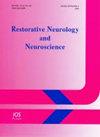伽玛刀放射外科治疗三叉神经痛
IF 1.6
4区 医学
Q4 NEUROSCIENCES
引用次数: 0
摘要
背景:三叉神经痛(TN)影响多达0.3%的人群,疼痛往往难以控制。它通常影响50岁以上的患者,在女性中更常见。治疗方案包括药物治疗、手术(微血管减压(MVD)和经皮球囊压缩(PBC))和伽玛刀放射手术(GKRS)。自2015年10月起,亚历山德拉公主医院开始提供GKRS。我们的目的是评估GKRS对TN患者的疗效,并研究已知预后变量对患者预后的影响。方法:回顾性分析2015年10月至2018年3月在某单中心三级神经外科转诊医院接受GKRS治疗TN的患者。结果:43例TN患者接受GKRS治疗,治疗后中位随访时间为7个月(6周~ 36个月)。中位年龄69岁,51%为女性,21%有不典型症状。33%既往有手术(7例为MVD, 7例为PBC)。GKRS治疗后1个月的临床获益率为79%,3个月为73%,6个月为74%,1年为87%。在GKRS后1年内疼痛复发的49%患者中,复发的中位时间为8周。无严重不良事件或严重毒性记录。预测较差结果的患者和治疗因素是存在接触神经的血管、女性和较高的辐射剂量。结论:GKRS是TN患者的一种有效的治疗选择,对于有合并症且手术风险高的患者尤其有用。GKRS对TN具有可接受的短期有益效果,但复发时可能需要其他治疗方案。本文章由计算机程序翻译,如有差异,请以英文原文为准。
Gamma Knife® radiosurgery for trigeminal neuralgia
Background: Trigeminal neuralgia (TN) affects up to 0.3% of the population with pain often difficult to manage. It commonly affects patients over 50 years, and occurs more frequently in women. Treatment options include medical therapy, surgery (microvascular decompression (MVD) and percutaneous balloon compression (PBC)) and Gamma Knife® radiosurgery (GKRS). GKRS has been available at the Princess Alexandra Hospital since October 2015. Our objective was to evaluate the efficacy of GKRS on patients with TN and investigate the impact of known prognostic variables on patient outcomes. Method: A retrospective review was conducted on all patients who received GKRS for TN from October 2015 till March 2018 in a single center tertiary neurosurgical referral hospital. Results: 43 patients with TN were treated with GKRS with a median follow up time after treatment of 7 months (6 weeks - 36 months). Median age was 69 years, 51% were female and 21% had atypical symptoms. 33% previously had surgery (7=MVD, 7=PBC). Clinical benefit after GKRS was observed in 79% of patients at 1 month, 73% at 3 months, 74% at 6 months and 87% at 1 year. Of the 49% who experienced a relapse of pain within 1 year post GKRS, the median time to relapse was 8 weeks. No serious adverse events or severe toxicity were recorded. Patient and treatment factors that predicted worse outcomes were the presence of a vessel contacting the nerve, female gender and a higher radiation dose. Conclusion: GKRS is an effective treatment option for patients with TN and it is particularly useful to consider in those with co-morbidities that make surgery high risk. GKRS has acceptable short-term beneficial results in TN, however with relapse other treatment options may be required.
求助全文
通过发布文献求助,成功后即可免费获取论文全文。
去求助
来源期刊
CiteScore
5.40
自引率
3.60%
发文量
22
审稿时长
>12 weeks
期刊介绍:
This interdisciplinary journal publishes papers relating to the plasticity and response of the nervous system to accidental or experimental injuries and their interventions, transplantation, neurodegenerative disorders and experimental strategies to improve regeneration or functional recovery and rehabilitation. Experimental and clinical research papers adopting fresh conceptual approaches are encouraged. The overriding criteria for publication are novelty, significant experimental or clinical relevance and interest to a multidisciplinary audience. Experiments on un-anesthetized animals should conform with the standards for the use of laboratory animals as established by the Institute of Laboratory Animal Resources, US National Academy of Sciences. Experiments in which paralytic agents are used must be justified. Patient identity should be concealed. All manuscripts are sent out for blind peer review to editorial board members or outside reviewers. Restorative Neurology and Neuroscience is a member of Neuroscience Peer Review Consortium.

 求助内容:
求助内容: 应助结果提醒方式:
应助结果提醒方式:


